Effects of crop production practices on soil characteristics and metabolic diversity of microbial communities under winter wheat
Anna M. Gajda A D , Ewa A. Czyż B , Karolina Furtak
A D , Ewa A. Czyż B , Karolina Furtak  A and Krzysztof Jończyk C
A and Krzysztof Jończyk C
A Department of Agriculture Microbiology, Institute of Soil Science and Plant Cultivation – State Research Institute, Czartoryskich Street 8, 24-100 Puławy, Poland.
B Department of Soil Science, Environmental Chemistry, and Hydrology, Faculty of Biology and Agriculture, Rzeszów University, Zelwerowicza Street 8 B, 35-601 Rzeszów, Poland.
C Department of Systems and Economics Crop Production, Institute of Soil Science and Plant Cultivation – State Research Institute, Czartoryskich Street 8, 24-100 Puławy, Poland.
D Corresponding author. Email: ag@iung.pulawy.pl
Soil Research 57(2) 124-131 https://doi.org/10.1071/SR18113
Submitted: 25 April 2018 Accepted: 4 December 2018 Published: 24 January 2019
Journal Compilation © CSIRO 2019 Open Access CC BY-NC-ND
Abstract
The aim of this research was to compare the effects of organic (ORG, no mineral fertilisers and pesticides) and conventional (CON, with mineral fertilisation and plant protection chemicals) crop production systems on some soil properties: soil organic matter (SOM) and particulate organic matter (POM) contents, dehydrogenase activity and metabolic microbial diversity (Biolog EcoPlate™). Samples of Haplic Luvisol soil were collected from 23-year-old experimental fields under winter wheat from the depth layers of 0–5, 5–10, 15–20 and 30–35 cm. Soil under ORG showed higher contents of SOM, POM and POM expressed as a percentage of SOM by 16.0%, 25.6% and 23.9% respectively, in particular down to 5 cm depth, compared with the CON system. Also, dehydrogenase activity was 47.5% higher under the ORG than the CON system. The Biolog EcoPlate revealed higher metabolic microbial diversity in soil under ORG crop production system compared with CON. This result was supported by the average well colour development and Shannon’s diversity index values. Significant correlations between soil quality parameters and winter wheat yield confirmed their effectiveness as indicators of soil disturbance. The results showed that the ORG system much better maintained SOM and soil fertility compared with CON.
Additional keywords: Biolog EcoPlate, management systems, microbial metabolic diversity, soil properties, Triticum aestivum L.
Introduction
More attention should be paid to the introducing into broad agricultural practice of management systems that meet the principles of protection of both the soil and the agro-ecosystem, which would allow today’s agriculture to fulfil requirements related to protection of soil quality (Doran et al. 1996). Conventional production systems maximise yields through intensive soil fertilisation and the use of pesticides to protect plants. Such practices often lead to deterioration of biological and physicochemical soil properties. In recent years, there has been increasing interest in and development of organic practices. The organic production system is one alternative to conventional agriculture (Marinari et al. 2006; Kuś and Jończyk 2008; de Ponti et al. 2012), and stimulates the microbial activity and diversity at or near the soil surface (Gajda et al. 2016).
The activities in soil of various enzymes, mostly of microbial origin, determine the decomposition of soil organic matter (SOM) and nutrient cycling (Marinari et al. 2006). The SOM is a key factor affecting the soil directly by supplying nutrients or indirectly modifying its physical, chemical and microbiological properties and so improving soil environment quality for microorganisms and plant growth (Liebig and Doran 1999). Particulate organic matter (POM) is a type of SOM fraction, and has been demonstrated as a useful tool in the process of orientation of research on SOM (Sequeira et al. 2011). The POM is the SOM fraction of size in the range 0.053–2 mm (Cambardella and Elliott 1992) – it is regarded as the most labile component of SOM and is important for chemical and microbial transformation processes of carbon (C) in soil (Baldock and Skjemstad 2000). The POM is considered to be the intermediate state between fresh, readily-decomposable organic (usually plant) remains and the more decomposed and stable SOM (humus).
Healthy ecosystems are usually characterised by high species diversity, and the Biolog EcoPlate™ method is often used to analyse functional diversity in soil microbial communities (Furtak et al. 2017; Li et al. 2017). EcoPlate allows testing for several substrates and enables evaluations of metabolic potential diversity of microbial populations in different environmental samples. The substrates on the EcoPlate are naturally occurring in the soil environment and some are products of exudates of plant roots (Preston-Mafham et al. 2002). This method provides many results on metabolism of microorganisms that correlate with other soil quality indicators (Gałązka et al. 2017).
The influence of agricultural techniques on the diversity of soil microorganisms is well known (Liebig and Doran 1999; Wolińska et al. 2017). The objective of the present study was to evaluate the effects of conventional and organic crop production systems on chosen soil characteristics: chemical (SOM and POM contents) and microbiological (dehydrogenase activity (DHA) and metabolic microbial diversity using EcoPlate).
Material and methods
Field experiment and soil sampling
This study was conducted during 2015–2017 in a long-term field experiment established in 1994 (area of each field ~1 ha) and located predominantly on Haplic Luvisol soil at the Experimental Station of Institute of Soil Science and Plant Cultivation State Research Institute (IUNG – PIB) in Osiny (Lublin Voivodeship; 51°28ʹ N, 22°30ʹ E), Poland. Winter wheat (Triticum aestivum L.) cv. Jantarka was grown in two different crop production systems: organic (ORG) and conventional (CON). The ORG included a crop rotation of potato–spring barley–grass/clover mixture (1st year) and grass/clover mixture–winter wheat (2nd year), with grass/clover compost (30 t ha–1) applied under potato. No mineral fertilisers and plant protection chemicals were used. Weed control was mainly by mechanical treatments. The CON system was based on mouldboard ploughing inverting soil to 20 cm depth and crop rotation of winter rape–winter wheat–spring barley, and mineral fertilisation and plant protection chemicals. Organic fertilisation was limited to winter rape and winter wheat straw spread on the field surface after the fall harvest and ploughed into the soil. In the CON system, crops were grown according to the high-input recommendations generally used in Poland. The tillage treatment for each field always remained the same. Crops in this experiment were grown in different crop production systems on non-replicated fields. More information about the field experiment can be found in Kuś and Jończyk (2008). The weather conditions in the experimental fields are shown in Table 1. Each year, soil samples for analysis were collected throughout the growing season, at ear formation (55–56 BBCH) and at harvest. The representative soil samples (~1500 g each) were taken from the in-row planting area from the depths of arable layer (0–5, 5–10 and 15–20 cm) and sub-arable layer (30–35 cm) randomly across each trial and transferred to the laboratory in coolers. Plant roots were carefully removed from soil before the analysis procedure.

|
Then, soil samples were weighed and 15 g of subsamples were dried at 105°C for 24 h to determine soil water content. Next, soil samples were sieved through a 2-mm sieve and stored at 4°C until analysis. Some soil chemical characteristics are contained in Table 2.
SOM and POM contents
The SOM content was measured with the K2Cr2O7–H2SO4 wet oxidation Tiurin method. For POM analysis, representative air-dry soil samples were dispersed with 100 mL of sodium hexametaphosphate (5 g L–1) and shaken for 18 h on a reciprocal shaker at ~180 oscillations min–1. Next, the dispersed soil was passed through 500- and 53-µm sieves. Particles retained on the 53-µm sieve corresponded to the POM fraction. The quantities of the POM fraction were measured according to Cambardella and Elliott (1992), in a modified method, in which POM content was estimated with loss-on-ignition (LOI) procedure (Schulte and Hopkins 1996), as detailed by Gajda et al. (2001). For calculations of the percentage of POM in total SOM, the SOM content was assessed using the LOI procedure.
DHA
The DHA was evaluated spectrophotometrically by the reduction of triphenyl tetrazolium chloride to triphenyl formazan (TPF) (Polish Standard PN–EN ISO 23753–1, 2011). The DHA values were calculated based on oven-dry (105°C) weight of soil.
Metabolic diversity of microbial communities
The Biolog EcoPlate (Biolog Inc., Hayward, CA, USA) method was used to evaluate diversity in metabolic activity of soil microorganisms. Each plate contained 31 different sole C sources and water (as a blank sample) in three replicates. The C sources distributed in 96 wells on each plate were subdivided into five groups of substrates: carbohydrates (CH), carboxylic acids (CXA), amino acids (AA), amines and amides (AMAD) and polymers (PLM) (Weber and Legge 2009). The utilisation rate of each group was measured by reduction of a redox indicator dye tetrazolium violet that changes from colourless to purple. One gram of each fresh soil sample was suspended in 99 mL of sterile water and shaken for 20 min. Next, the suspensions were incubated at 4°C for 30 min (Weber and Legge 2009; Gajda et al. 2017). After this, solutions were filtered (Bag Filter, Interscience, Paris, France). Then, 120 µL of the sample was applied to each well on EcoPlate and incubated at 25°C for 120 h. The absorbance at 590 nm was measured every 24 h with a plate reader Biolog MicroStation™ (Biolog Inc.).
Statistical analyses
Statistical analyses were performed using Statistica ver. 10.0 software (Stat. Soft Inc., Tulsa, OK, USA) and ANOVA. The significant differences within the data were calculated according to post-hoc Tukey’s HSD (honest significant differences) and post-hoc Fisher’s l.s.d. (least significant difference) tests at P < 0.05. Pearson’s correlation coefficients were calculated to show relationships between soil properties and winter wheat yield (WWY) at P < 0.01 and P < 0.05.
Based on the data (OD590) obtained from EcoPlate after 120 h of incubation, Shannon’s diversity (Hʹ) index was calculated (Hill et al. 2003) and a heat map created (Stat. Soft Inc.). Average well colour development (AWCD) was measured as a mean of optical densities from 31 wells as given in Garland and Millis (1991).
Results
SOM and POM contents
The ORG system favoured increase in SOM content (17.0 g kg–1 of soil), in particular at the top soil (0–5 cm) compared with CON (14.3 g kg–1 of soil) (Fig. 1). In the sub-arable layer (30–35 cm) an inverse image of the SOM content was observed in relation to upper soil layers (0–5, 5–10 and 15–20 cm). The SOM content in sub-arable soil was 1.5 times higher in CON compared with ORG system (5.7 g kg–1 of soil).
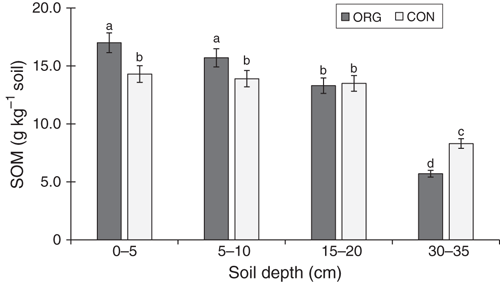
|
A good and sensitive parameter in monitoring changes in soil environment is POM, a biologically active fraction of SOM (Fig. 2). The POM content in top soil (0–5 cm) for ORG was 3.9 g kg–1 air-dry soil and was 25.6% higher than under CON. In ORG, the POM content decreased with increased soil depth, but no such relationship was observed in CON. In sub-arable soil, the POM content was 76% lower, on average, compared with upper soil layers (0–5, 5–10 and 15–20 cm).
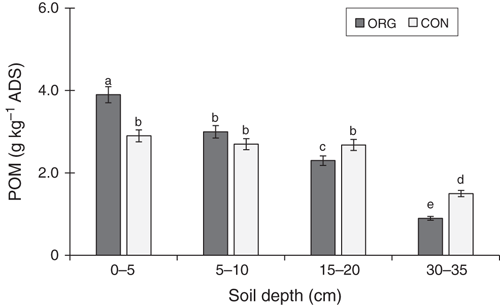
|
Compared with POM, the changes in SOM content in soil under both crop production systems were difficult to detect within the three-year study (Fig. 3a, b). The POM content in soil under ORG measured in 2017 was significantly higher (twice, on average) than in 2015, whereas in the same soil under CON the POM increase was negligible (Fig. 3b). The positive effects on soil of the ORG system were also reflected in changes in the percentage of POM in total SOM (Fig. 4). In ORG, especially in the top soil layer (0–5 cm), there was a significantly (P < 0.05) greater percentage of POM in SOM (23.9%) than in CON (20.3%).
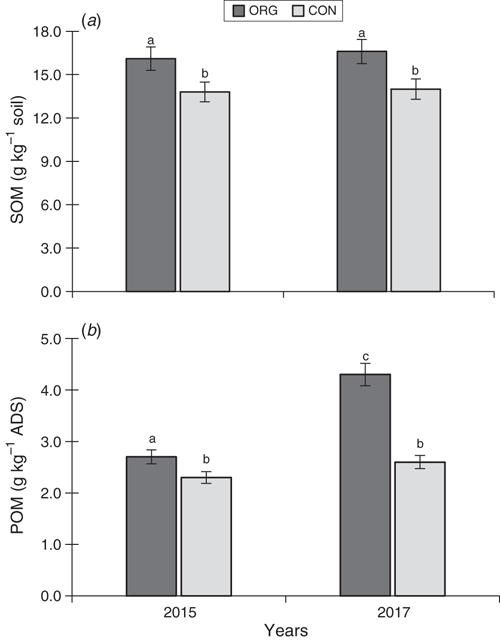
|
DHA
The studied crop production systems significantly determined the soil microbial activity measured as DHA (Fig. 5). The DHA in the 0–5 cm soil layer was 47.5% higher in ORG than CON (0.16 and 0.11 mg TPF g DW soil–1 24 h–1 respectively). The DHA in the sub-arable soil layer (30–35 cm) was significantly lower than in the arable layer (0–20 cm) for both ORG and CON systems, but the DHA decrease with depth was more marked for ORG than CON.
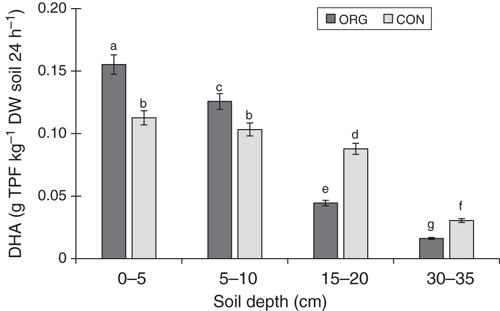
|
Diversity and metabolic activity of soil microbial communities
The abilities of the microbial communities in soil under ORG and CON systems to utilise specific C-substrates were analysed using EcoPlate (Figs 6–9). Optical density values at 120 h of incubation were used to assess microbial functional diversity and for statistical analyses because at that time the highest activity of soil microorganisms was recorded.
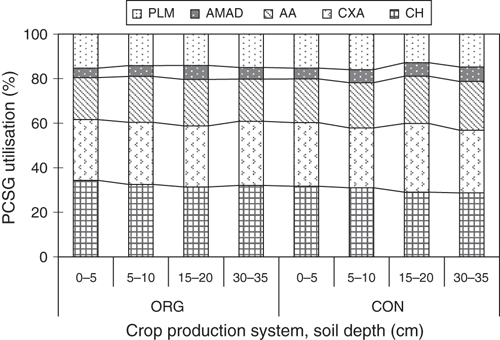
|
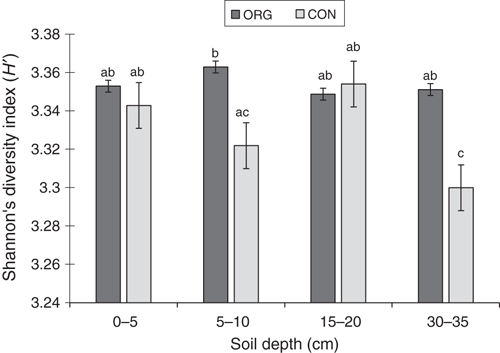
|
It was observed that some C substrates were utilised differently and some similarly by microorganisms inhabiting soil under the two crop production systems. Also, the rate of C-substrate utilisation was influenced by depth in the soil profile. In the ORG system, the highest utilisation rates of C sources by microbial communities were for the CH group (34.3%) in the top soil (0–5 cm); and in the CON system, the CXA group (30.8%) in the 15–20 cm layer. In the other studied soil layers, the microbial communities utilised the CH and CXA groups at a similar rate, with no significant differences observed. The least used C sources by soil microorganisms for both crop systems was the AMAD group (5.1% in ORG and 5.6% in CON, on average), but with significant differences in the rate of utilisation between crop systems in the 0–5, 5–10 and 30–35 cm layers. Also, utilisation rate of the PLM group differed significantly in both crop systems, particularly in the 5–10 cm layer by ~2.0%. In the sub-arable layer (30–35 cm) the CXH and PLM utilisation rates showed negligible differences between the two crop systems, but the CH, AA and AMAD groups were utilised at significantly (P < 0.05) different rates between the systems (3.0% difference, on average).
The AWCD values showed differences in microbial metabolic activity between the two crop systems (Fig. 7). In all arable soil layers (0–5, 5–10 and 15–20 cm) the AWCD values were higher in the ORG (1.64–1.67) than the CON system (1.47–1.60), but the difference (12%) was only significant in the 5–10 cm layer. In the sub-arable layer (30–35 cm), the AWCD value was ~8% higher in the ORG than the CON system.
The Hʹ values indicated the effects of studied crop production systems on the metabolism of soil microorganisms (Fig. 8). In general, higher values of Hʹ characterised soil under the ORG compared with the CON system. The highest Hʹ values were in the ORG system for the 5–10 cm layer (3.36, on average); the lowest Hʹ values were in soil at 30–35 cm in CON (3.30). There were significantly (P < 0.05) higher Hʹ values for ORG compared to CON in soil at 5–10 and 30–35 cm depths.
A heat map was generated for better visualisation of similarities and dissimilarities in C-substrate utilisation rates by soil microbial communities between the crop systems (Fig. 9).
WWY
In our studies, the WWY differed for the ORG and CON systems with 6.38 and 8.14 t ha–1 respectively (Table 3). The higher WWY in the CON system may be due to relatively high yield losses as a result of pests and diseases and phosphorus limitations in the ORG system (Table 2).

|
Correlations among soil properties
There were strong correlations (P < 0.01) between DHA and SOM (0.931) and POM (0.969) (Table 4). There were also significant (P < 0.05) positive correlations of WWY with SOM (0.783), POM (0.587), DHA (0.512) and precipitation (0.445).
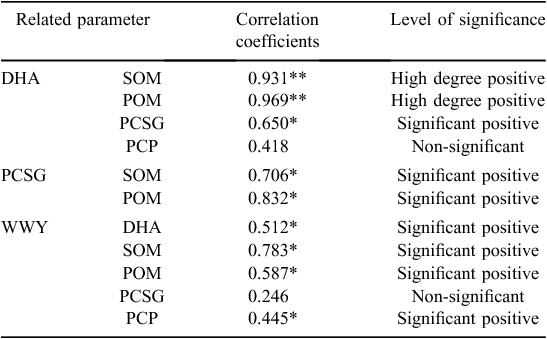
|
Discussion
In our studies, positive effects of the ORG system on SOM content in soil were observed. Several studies have shown that SOM decreases in intensively-managed cropland soils (Liebig et al. 2004; de Ponti et al. 2012; Gajda et al. 2016). Management systems that affect SOM accumulation usually also affect the content of the labile POM fraction. Cambardella and Elliott (1992) reported that POM is preferentially depleted compared to SOM with increasing intensity of tillage. As a readily available source of soil nutrients, POM contributes to improved soil structure and is very sensitive to soil management, and therefore is frequently used as an indicator of soil quality (Liebig et al. 2004; Gajda et al. 2016). The high POM content in soil is an indicator of soil organic C and other nutrients stored in an intermediary pool, which are protected from losses and available when needed. Within our three-year study, the quantitative changes in POM content showed relatively early the direction of ongoing changes in SOM induced by crop production systems, while changes in SOM content were scarcely noticeable in the same period. The positive effects of the ORG system on soil were well described by changes in the percentage of POM in total SOM. The significant differences in the percentage of POM in total SOM between the two crop production systems were mostly in the surface soil (20.3%) in favour of ORG. Cambardella et al. (2001) reported that the share of POM ranged within 10–45% in soils of the Great Plains, USA. These results indicated that POM is important to SOM turnover and responds much faster to changes in soil caused by management than does the total SOM. Similar effects of farming practices on the content of the labile POM fraction in soil were reported by Marriott and Wander (2006) and Gajda et al. (2016).
Many researchers have reported that crop production systems greatly influence the activity of soil microbial communities, very often is measured in terms of DHA (Marinari et al. 2006; Karaca et al. 2011). This group of enzymes is widely used as a good indicator of changes in soil microbial activity (Wolińska et al. 2017). In our studies, the ORG system enhanced SOM and its labile fraction POM content which positively influences the abundance and activity of microbial communities, as reflected in higher DHA, compared with the CON system. Our results are supported by the findings of Järvan et al. (2014), who concluded that an organically-managed crop rotation significantly increased the number of soil microbial communities and the DHA. Also, Heidari et al. (2016) showed beneficial effects of no-tillage and organic fertilisation on enzyme activities in contrast to conventionally managed soil. The authors of most published results have mentioned that soil microbial diversity and abundance, and soil enzymatic activity, are significantly greater for organic compared with conventional management (Karaca et al. 2011).
Knowledge of the diversity of soil microbial communities is crucial to understanding soil function in the ecosystem (Nannipieri and Badalucco 2003). The C-substrate utilisation pattern indicated that studied crop production systems influenced soil microorganisms, and that the ORG system created a more favourable environment for soil microbial communities and their metabolic activity compared with CON. Liu et al. (2007) observed that functional diversity as indicated by C-substrate utilisation patterns was considerably higher in organic than conventional management practice.
The AWCD index is very useful to characterise activity and diversity of microbial populations (Furtak et al. 2017). It characterises well the oxidative ability of microorganisms developed in the EcoPlate system and may serve as an indicator of microbial activity (Garland and Millis 1991). The EcoPlate results expressed as AWCD values showed some differences in the catabolic potential of microorganisms between systems of studied arable and sub-arable soil layers. That may indicate that agrotechnical treatments (e.g. ploughing) can spread microorganisms deeper into soil, in accordance with the results of Wang et al. (2007) and Gajda et al. (2016).
As is widely known, crop production systems affect crop yields by changing the soil properties (Mäder et al. 2002; Marinari et al. 2006). In this research, the ORG system resulted in a lower WWY than for the CON system. de Ponti et al. (2012), Bilsborrow et al. (2013), Švančárková and Żák (2015) and Gałązka et al. (2018) reported similar yields. An organic production system relies for its crop nutrients on natural soil fertility, whereas a conventional system relies on external inputs to maintain soil fertility. Crop yields are a result of the interaction of many overlapping factors, both related to applied agrotechnics and environment, e.g. weather conditions. Variability in meteorological conditions is a significant challenge to crop production and yield stability. Precipitation and temperature during the early vegetative and late reproductive phases of winter wheat growth explained much of the yield variation in our studied crop production systems, consistent with the results of Teasdale and Cavigelli (2017).
Although the yields in the ORG system varied considerably because of the high dependency on the weather, this system favours protection of soil quality as the main basis for crop production. Therefore, the ORG can be recommended as an alternative to the CON system.
Conclusions
Greater activity of soil microbial communities in a Haplic Luvisol soil was found under the ORG compared with CON production system. This activity was measured with dehydrogenases as well as metabolic diversity revealed by Biolog EcoPlate analysis and confirmed by AWCD and Hʹ results. Also, higher concentrations of POM and SOM were observed in soil under the ORG, particularly in the 0–5 cm layer, compared with the CON system. The results suggest that ORG much better maintained soil fertility than the CON system, which is extremely important for the soil environment and sustainable land use as it avoids SOM losses and soil degradation processes and improves the microbial status of soil. Therefore, legume-based crop rotations in an organic crop production system, utilising organic fertilisers generated within the system are a realistic alternative to the conventional crop production system. However, further field experiments are needed to monitor changes in the soil environment and to confirm the qualitative and quantitative long-term benefits of the applied crop production systems.
Conflicts of interest
The authors declare no conflicts of interest.
Acknowledgements
The research was conducted within the statutory activity of IUNG–PIB (2.26 and 2.38) and the frames of Task 1.3 and 1.4 Multi-Annual Program IUNG–PIB (2016–2020).
References
Baldock JA, Skjemstad JO (2000) Role of the soil matrix and minerals in protecting natural organic materials against biological attack. Organic Geochemistry 31, 697–710.| Role of the soil matrix and minerals in protecting natural organic materials against biological attack.Crossref | GoogleScholarGoogle Scholar |
Bilsborrow P, Cooper J, Tétard-Jones C, Średnicka-Tober D, Barański M, Eyre M, Schmidt CH, Shotton P, Volakakis N, Cakmak I, Ozturk L, Leiferta C, Wilcockson S (2013) The effect of organic and conventional management on the yield and quality of wheat grown in a long-term field trial. European Journal of Agronomy 51, 71–80.
| The effect of organic and conventional management on the yield and quality of wheat grown in a long-term field trial.Crossref | GoogleScholarGoogle Scholar |
Cambardella CA, Elliott ET (1992) Particulate soil organic matter. Changes across grassland cultivation sequence. Soil Science Society of America Journal 56, 777–783.
| Particulate soil organic matter. Changes across grassland cultivation sequence.Crossref | GoogleScholarGoogle Scholar |
Cambardella CA, Gajda AM, Doran JW, Wienhold BJ, Kettler TA (2001) Estimation of particulate and total organic matter by weight loss-on-ignition. In ‘Assessment methods for soil carbon’. (Eds R Lal, JM Kimble, RF Follett, BA Stewart) pp. 349–359. (CRC Press: Boca Raton, FL, USA)
de Ponti T, Rijk B, van Ittersum MK (2012) The crop yield gap between organic and conventional agriculture. Agricultural Systems 108, 1–9.
| The crop yield gap between organic and conventional agriculture.Crossref | GoogleScholarGoogle Scholar |
Doran JW, Sarrantonio M, Liebig M (1996) Soil health and sustainability. In ‘Advances in agronomy’. (Eds DL Spark) pp. 1–54. (Academic Press: San Diego, USA)
Furtak K, Gawryjołek K, Gajda AM, Gałązka A (2017) Effects of maize and winter wheat grown under different cultivation techniques on biological activity of soil. Plant, Soil and Environment 63, 449–454.
| Effects of maize and winter wheat grown under different cultivation techniques on biological activity of soil.Crossref | GoogleScholarGoogle Scholar |
Gajda AM, Doran JW, Kettler TA, Wienhold BJ, Pikul JL Jr, Cambardella CA (2001) Soil quality evaluations of alternative conventional management systems in the Great Plains. In ‘Assessment methods for soil carbon’. (Eds R Lal, JM Kimble, RF Follett, BA Stewart) pp. 381–400. (CRC Press: Boca Raton, FL, USA)
Gajda AM, Czyż EA, Dexter AR (2016) Effects of long-term use of different farming systems on some physical, chemical and microbiological parameters of soil quality. International Agrophysics 30, 165–172.
| Effects of long-term use of different farming systems on some physical, chemical and microbiological parameters of soil quality.Crossref | GoogleScholarGoogle Scholar |
Gajda AM, Czyż EA, Stanek-Tarkowska J, Dexter AR, Furtak KM, Grządziel J (2017) Effects of long-term tillage practices on the quality of soil under winter wheat. Plant, Soil and Environment 63, 236–242.
| Effects of long-term tillage practices on the quality of soil under winter wheat.Crossref | GoogleScholarGoogle Scholar |
Gałązka A, Gawryjołek K, Grządziel J, Frąc M, Księżak J (2017) Microbial community diversity and the interaction of soil under maize growth in different cultivation techniques. Plant, Soil and Environment 63, 264–270.
| Microbial community diversity and the interaction of soil under maize growth in different cultivation techniques.Crossref | GoogleScholarGoogle Scholar |
Gałązka A, Gawryjołek K, Gajda A, Furtak K, Księżniak A, Jończyk K (2018) Assessment of the glomalins content in the soil under winter wheat in different crop production systems. Plant, Soil and Environment 64, 32–37.
| Assessment of the glomalins content in the soil under winter wheat in different crop production systems.Crossref | GoogleScholarGoogle Scholar |
Garland JL, Millis AL (1991) Classification and characterization of heterotrophic microbial communities on the basis of patterns of community-level sole-carbon-source utilization. Applied and Environmental Microbiology 57, 2351–2359.
Heidari G, Mohammadi K, Sohrabi Y (2016) Responses of soil microbial biomass and enzyme activities to tillage and fertilization systems in soybean (Glycine max. L.) production. Frontiers of Plant Science 7, 1730
| Responses of soil microbial biomass and enzyme activities to tillage and fertilization systems in soybean (Glycine max. L.) production.Crossref | GoogleScholarGoogle Scholar |
Hill TCJ, Walsh KA, Harris JA, Moffett BF (2003) Using ecological diversity measures with bacterial communities. FEMS Microbiology Ecology 43, 1–11.
| Using ecological diversity measures with bacterial communities.Crossref | GoogleScholarGoogle Scholar |
Järvan M, Edesi L, Adamson A, Võsa T (2014) Soil microbial communities and dehydrogenase activity depending on farming systems. Plant, Soil and Environment 60, 459–463.
| Soil microbial communities and dehydrogenase activity depending on farming systems.Crossref | GoogleScholarGoogle Scholar |
Karaca A, Cema CC, Turgay OC, Kizilkaya R (2011) Soil enzymes as indicator of soil quality. In ‘Soil enzymology’. (Eds G Shukla, A Varma) pp. 119–148. (Springer-Verlag: Berlin, Heidelberg, Germany)
Kuś J, Jończyk K (2008) Influence of organic and conventional crop production system on some parameters of soil fertility. Journal of Research and Applications in Agricultural Engineering 53, 161–165.
Li G, Kim S, Park M, Son Y (2017) Short-term effects of experimental warming and precipitation manipulation on soil microbial biomass C and N, community substrate utilization patterns and community composition. Pedosphere 27, 714–724.
| Short-term effects of experimental warming and precipitation manipulation on soil microbial biomass C and N, community substrate utilization patterns and community composition.Crossref | GoogleScholarGoogle Scholar |
Liebig MA, Doran JW (1999) Impact of organic production practices on soil quality indicators. Journal of Environmental Quality 28, 1601–1609.
| Impact of organic production practices on soil quality indicators.Crossref | GoogleScholarGoogle Scholar |
Liebig MA, Tanaka DL, Wienhold BJ (2004) Tillage and cropping effects on soil quality indicators in the northern Great Plains. Soil & Tillage Research 78, 131–141.
| Tillage and cropping effects on soil quality indicators in the northern Great Plains.Crossref | GoogleScholarGoogle Scholar |
Liu B, Tu C, Hu S, Gumpertz M, Ristaino JB (2007) Effect of organic, sustainable, and conventional management strategies in grower fields on soil physical, chemical, and biological factors and the incidence of Southern blight. Applied Soil Ecology 37, 202–214.
| Effect of organic, sustainable, and conventional management strategies in grower fields on soil physical, chemical, and biological factors and the incidence of Southern blight.Crossref | GoogleScholarGoogle Scholar |
Mäder P, Fliefibach A, Dubois D, Gunst L, Fried P, Niggli U (2002) Soil fertility and biodiversity in organic farming. Science 296, 1694–1697.
| Soil fertility and biodiversity in organic farming.Crossref | GoogleScholarGoogle Scholar | 12040197PubMed |
Marinari S, Mancinelli R, Campiglia E, Grego S (2006) Chemical and biological indicators of soil quality in organic and conventional farming systems in Italy. Ecological Indicators 6, 701–711.
| Chemical and biological indicators of soil quality in organic and conventional farming systems in Italy.Crossref | GoogleScholarGoogle Scholar |
Marriott EE, Wander M (2006) Qualitative and quantitative differences in particulate organic matter fractions in organic and conventional farming systems. Soil Biology & Biochemistry 38, 1527–1536.
| Qualitative and quantitative differences in particulate organic matter fractions in organic and conventional farming systems.Crossref | GoogleScholarGoogle Scholar |
Nannipieri P, Badalucco L (2003) Biological processes. In ‘Handbook of processes in the soil–plant system: modelling concepts and applications’. (Eds DK Bembi, R Nieder) pp. 57–76. (The Haworth Press: Binghamton NY, USA)
Preston-Mafham J, Boddy L, Randerson PF (2002) Analysis of microbial community functional diversity using sole-carbon-source utilisation profiles - a critique. FEMS Microbiology Ecology 42, 1–14.
Schulte EE, Hopkins BG (1996) Estimation of organic matter by weight loss-on-ignition. In ‘Soil organic matter: analysis and interpretation’. (Eds FR Magdoff et al.) pp. 21–31. (SSSA: Madison, WI, USA)
Sequeira CH, Alley MM, Jones BP (2011) Evaluation of potentially labile soil organic carbon and nitrogen fractionation procedures. Soil Biology & Biochemistry 43, 438–444.
| Evaluation of potentially labile soil organic carbon and nitrogen fractionation procedures.Crossref | GoogleScholarGoogle Scholar |
Švančárková M, Żák Š (2015) The grain quality of winter wheat in organic and conventional farming. Acta Fytotechnica et Zootechnica 18, 22–24.
| The grain quality of winter wheat in organic and conventional farming.Crossref | GoogleScholarGoogle Scholar |
Teasdale JR, Cavigelli MA (2017) Meteorological fluctuations define long-term crop yield patterns in conventional and organic production systems. Scientific Reports 7, 688
| Meteorological fluctuations define long-term crop yield patterns in conventional and organic production systems.Crossref | GoogleScholarGoogle Scholar | 28386102PubMed |
Wang GH, Jin J, Chen XL, Liu JD, Liu XB, Herbert SJ (2007) Biomass and catabolic diversity of microbial communities with long-term restoration, bare follow and cropping history in Chinese Mollisols. Plant, Soil and Environment 53, 177–185.
| Biomass and catabolic diversity of microbial communities with long-term restoration, bare follow and cropping history in Chinese Mollisols.Crossref | GoogleScholarGoogle Scholar |
Weber KP, Legge RL (2009) One-dimensional metric for tracking bacterial community divergence using sole carbon source utilization patterns. Journal of Microbiological Methods 79, 55–61.
| One-dimensional metric for tracking bacterial community divergence using sole carbon source utilization patterns.Crossref | GoogleScholarGoogle Scholar | 19647767PubMed |
Wolińska A, Górniak D, Zielenkiewicz U, Goryluk-Salmonowicz A, Kuźniar A, Stępniewska Z, Błaszczyk M (2017) Microbial biodiversity in arable soils affected by agricultural practices. International Agrophysics 31, 259–271.
| Microbial biodiversity in arable soils affected by agricultural practices.Crossref | GoogleScholarGoogle Scholar |






